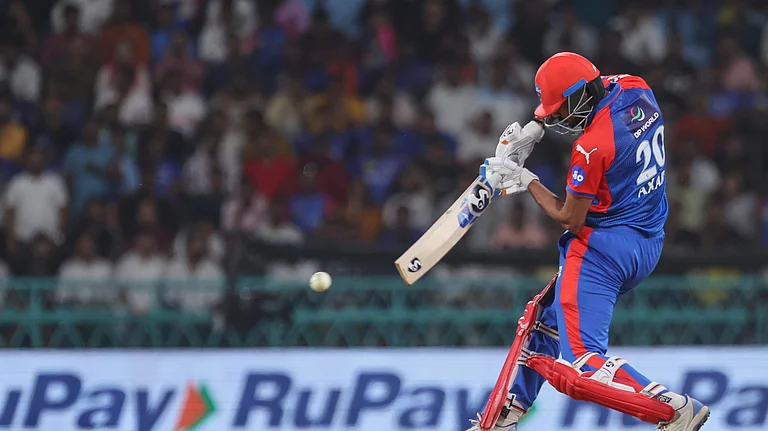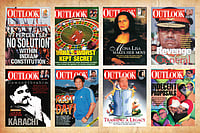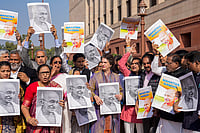ROOTS always held the promise of redemption for painter Manjit Bawa, 55. They were the young painter and screen printer's security through those days of Southall activism in racist '60s London; his inspiration during the '70s when upon his return from London he started painting those fantastical forms, flat colour tones strongly reminiscent of Basholi hill school paintings; his solace during that traumatic time in 1984 when he worked tirelessly at rescuing and rehabilitating riot victims in Delhi. That was when he rediscovered Baba Fareed, Bulle Shah and Waris Shah whose simple Sufi lyrics held out assurance that some meaning would emerge from the madness. Night after night Manjit the mystic sang out those songs of hope and wisdom on a battered harmonium in the Jangpura home of friend, comrade-in-arms, Sufischolar and Delhi university academic, Madangopal. Happily for him and his art, it is to these Qadri Sufi Punjabi roots to which the painter has reverted for inspiration in his latest work, currently on display at Delhi's Gallery Espace. The exhibition, Bawa's first in five long years, is significant for the gleanings it provides of the new artistic direction taken by the painter who art historian Geeti Sen lauds for a "sure aesthetic, canny gut instinct".
That gut instinct seemed to have failed him lately. Gallery owners, collectors, crit -ics alike complained about the wearying recurrence of staple Bawa motifs—"gingerbread men, staple brilliants, clear tones"—on each canvas, panned his unfortunate experimental "drawing and drivel" exercises with Pritish Nandy, carped about his "glib felicity", sheer "quantity killing his quality", bemoaned his aesthetic stasis. Bawa responded by going into hibernation. He worked 12-hour days, experimented with creating joint works with Iranian artist Parwanee Itimahdi, designing jewellery, objets d' art for Bangalore collector Abhishek Poddar, devising cutouts, murals for a Delhi restaurant with Rajiv Sethi, sketched, painted and resolutely turned down gallery owners clamouring for shows, clients pleading for canvases. Not an easy decision for one whose 12inch by 14 inch charcoal on paper drawings sell for as much as Rs 12,500, whose 20 inch by 20 inch oils on canvas sell for a steep Rs 2,25,000 in what, for him, has been a seller's market for over a decade. He grabs your hand, leads you into his studioto substantiate that last claim. The floor mattress is pulled aside to reveal bundles of currency notes. "Yesterday a lady forced me to keep this as payment for a work I said I would not do till next year," he explains. "I don't like this pressure...prefer to follow my creative instincts rather than client diktats."
BAWA'S decision to follow his own diktats, eschew commerce in favour of creativity, opt for introspection rather than instant expression has paid off. The work displayed in this exhibition is far more meditative, textured, than his earlier work. Bawa leitmotifs do abound: clear tones, peori yellows, cadmium reds, glowing oranges, luminous greens, purples that challenge you with their daunting depths, candyfloss pinks. So do staple Bawa images of Krishna, now with flute and cow, another time wrestling with a bull. But there are also striking new images. Two sweeping oils on canvas depict a female circus acrobat perched precariously high above the ground on a stick, her diaphanous dupatta wafting in the breeze like a pair of wings. An image at once myth and reality, traditional and contemporary, imbued with both tension and abandon. This is Bawa with a twist: he's explored the circus theme earlier but this is acrobat as icon, artistic device as deity and central figure. Uncharacteristically for Bawa, the colours are muted. The drama is in the image.
But nowhere has his artistic radar, that celebrated gut instinct, served him better than in his explorations of his Punjabi Sufi cultural roots through a series of 12 inch by 14 inch charcoal on paper drawings he's exhibiting alongside his canvases. This is Bawa the Bard drawing from his Punjabi roots to infuse his work with soul. "Bawa always had three faces," explains Sen, "the earthy Punjabi, the mystic fakeer and aghora and Bawa the Cult that he became in the late '80s. The first two have more integral value." It's that artistic integrity rather than gimmickry that shines through in these drawings. The canvases are about flourish, the drawings about feeling. Bawa reveals himself as master of the minimal. These haiku images compress within them whole worlds of feeling, narrate Sufiparables with stunning simplicity. For Bawa, the songs of the Sufi bards have contemporary relevance. "Heer Ranjha is a tale of secular amity: Waris Shah was a Muslim poet singing of the love between a Hindu Heer and a Muslim Ranjha who in turnhad a Hindu guru, Baba Balaknath. I think we forgot that in 1984," says the man who rescued riot victims, often at great personal risk, during that time of unthinking hatred. The Ranjha tale is simply depicted in a work where a shaven-headed Ranjha stands before Balaknath, seated on a tigerskin, pleading to be accepted as a shishya. "Balaknath agreed," explains Bawa, "overruling other shishyas' objections saying, 'Can you not see he is rendered divine by the love he feels? How does it matter if he's Muslim?' " The painter's mistrust of the sham and negativity that is organised religion finds expression in another image where Heer flanked by a tiger—"a woman as shakti motif," explains Bawa—berates a cowering mullah who questions her about flouting her marriage vows. "She calls him a liar, saying her consent was presumed, not articulated. Waris Shah has her commit the ultimate heresy, call the mullah a liar. The dog nipping at his heels completes his humiliation," says Bawa. "Small wonder," he says, "that Qadri Sufis were considered heretics, beaten, chased away from people's doors. Those who speak the truth usually are." The image that stays with one is that of the serene fakeer with a dog. In Punjabi, Bawa sings the Bulle Shah lyric the lines of the image represent. "The dog roamed the streets by day, At night at his master's doorway he lay, Never mind insult Bulle, Leave not the beloved's door, Else the dog over you will score." In times of faithlessness, says Bawa, "you only have love to turn to for salvation". And roots, he might have added. A return to which, as in these works, has spelt artistic and spiritual salvation for this artist.


























